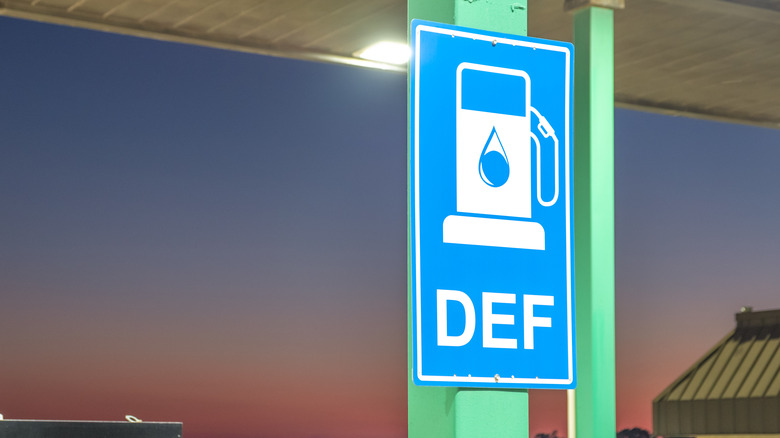How Long Is Diesel Exhaust Fluid (DEF) Good For After Opening?
If you regularly drive a modern-day diesel-powered vehicle, chances are, you know what Diesel Exhaust Fluid (DEF) is. A crucial component used by most modern vehicles with diesel engines, DEF — which is also known as AdBlue in some markets — is a chemical solution composed of deionized water and urea. Its primary purpose is to cut down the notoriously harmful nitrogen oxide (NOx) emissions that diesel engines are infamous for. DEF works by splitting the nitrogen oxide (NOx) molecule into harmless water vapor and nitrogen gas, which can then be safely released into the air.
In the U.S., all diesel-powered vehicles built since 2010 are equipped to use DEF to adhere to the norms put forth by the Environmental Protection Agency (EPA). DEF is typically stored in a dedicated, separate tank on diesel vehicles. It is injected into a diesel vehicle's exhaust system while the engine is functioning, thereby ensuring that harmful NOx emissions are neutralized before it is released into the air.
DEF is not a fuel additive or performance booster. As outlined, it is just one of the ways in which harmful exhaust gases formed after diesel combustion are neutralized. Aside from the obvious environmental benefits, the use of DEF lets diesel-powered vehicles meet emission norms without having to make major engine modifications or sacrifice torque or efficiency.
DEF manufacturers typically give it a shelf life of 2 years if stored in optimal (40 to 80°F out of direct sunlight) conditions. This shelf life, however, only applies to unopened containers. If a sealed DEF container is opened, its shelf life reduces to just six months, albeit with several caveats.
The true shelf life of Diesel Exhaust Fluid
Some sources suggest that, when stored at temperatures below 50°F, the life of DEF can be extended up to 36 months. Additionally, the six-month shelf life for opened DEF packages is valid only if the same storage conditions as before (40 to 80°F, and away from sunlight) are met. It is, therefore, never a good idea to keep a DEF container in direct sunlight, inside a hot garage, or in a truck bed during summer. Doing any of these could cause the fluid to deteriorate even faster.
The biggest factors that could cause DEF to deteriorate include exposure to oxygen, humidity, or heat. These interactions cause the urea inside DEF to break down, altering the fluid's concentration. Over time, the decomposition process is accelerated, ending up increasing ammonia content and reducing the effectiveness of DEF.
Spotting deteriorating and aging DEF is not complicated. Fresh DEF is a clear, colorless liquid that may be virtually odorless or have a very faint ammonia-like smell. DEF that has started deteriorating will turn cloudy. In a clear container, you may also notice sedimentation and crystallization. A stronger ammonia odor is another indicator that decomposition has started. While the degradation process of DEF is gradual, once it starts, there's no practical way to "restore" DEF to its original quality. For the same reason, it's best to estimate your typical DEF consumption and avoid storing the fluid for extended periods, especially in warm or sun-exposed environments.
What happens if you use old DEF?
Given that the very purpose of using DEF is to limit NOx emissions, the major consequence of using contaminated or expired DEF would be increased emissions and, therefore, higher pollution. If left unchecked, it could even lead to a damaged catalytic converter — an important component of modern-day exhaust systems. The use of expired or poor-quality DEF may also cause the engine to switch to a low power mode as a safety measure and to prevent potential engine damage. An evident decrease in performance can, therefore, be seen as one of the markers of expired, or poor quality DEF.
Other ways in which one can detect DEF deterioration include a higher-than-usual consumption of DEF. If you observe that the DEF tank is getting emptier a lot faster than usual, old, contaminated DEF could be a reason. Most modern diesel vehicles also have DEF-specific warning lights that will indicate or flash if the system detects low-DEF quantity or quality issues with the liquid stored in the tank. If you see such warning lights or indicators, the best solution would be to empty the DEF tank and top it up with a fresh, uncontaminated DEF solution.
DEF is one of the reasons for diesel-powered vehicles to still operate while keeping emissions in check. Ensuring that your vehicle has an ample quantity of DEF in its tank and that it is of good quality will not only have a positive impact on the environment but will also ensure optimum performance of your vehicle throughout its lifetime.


